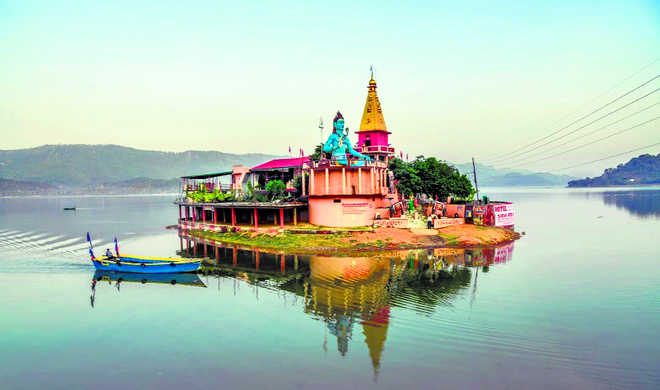Oustees’ struggle for water near state’s biggest man-made lake
Lalit Mohan
Call it irony, nearly 50 villages in Una and Bilaspur districts of Himachal, located on the banks of one of the biggest man-made lakes of the country — Gobind Sagar — are without drinking water supply.
Most of the residents of the affected villages are Bhakra Dam oustees. Salangari village in Una district is one such village. Though the IPH Department of the state has provided drinking water supply to the village, it faces acute shortage of drinking water in the summer season. Many villages also do not have access to roads as the BBMB has not allowed the construction of roads due to security reasons.
Romesh, a resident of Raipur village located on the banks of Gobind Sagar lake, said they had their agricultural land on the banks of the Sutlej before the Bhakra Dam was constructed. However, most of the fertile land of the area was submerged in Gobind Sagar lake. The villagers of the area were allotted lands in arid areas of Haryana and Rajasthan. Most of the oustees did not move to the land allotted to them and preferred staying at their villages.
“Today, we are sitting on the banks of Gobind Sagar lake, but do not have proper access to drinking or irrigation water. For agriculture, too, we are dependent on rains,” he said.
Suresh Kumar, another resident of Raipur, said Bhakra Dam had ushered a Green Revolution in Punjab and Haryana. However, for residents who were ousted, even drinking water was not available.
Gobind Sagar lake behind Bhakra Dam is spread across 88 sq km in Una and Bilaspur districts of Himachal.
The officials of the IPH Department admitted that there was acute shortage of drinking and irrigation water in many villages located on the banks of the lake. They said the underground water was very scarce in villages located on the banks. Permission has to be sought from the BBMB to lift water from the Gobind Sagar lake. In some villages, the lift irrigation and drinking water schemes have been installed. However, for others the problem persists.
Sources in the IPH Department said special lift irrigation schemes could be designed in areas of Himachal lying along the Gobind Sagar lake. However, for each of this scheme, permission would have to be sought from the BBMB. The BBMB comprises members of Punjab, Haryana and Rajasthan and in the past permissions were hard to get. In case permissions are given, sustainable water and irrigation schemes can be constructed for villages of Bhakra oustees.
Suresh said the oustees got worst compensation as compared to those of other dams or projects. They should have access to proper drinking and irrigation water at least since the Gobind Sagar lake was located in their land, he said.
We had our agricultural land on the banks of the Sutlej before the Bhakra Dam was constructed. However, most of the fertile land of the area was submerged in Gobind Sagar lake. The villagers of the area were allotted lands in arid areas of Haryana and Rajasthan. Most of the oustees did not move to the land allotted to them and preferred staying at their villages. Today, we are sitting on the banks of Gobind Sagar lake, but do not have proper access to drinking or irrigation water. For agriculture, too, we are dependent on rains. — Romesh, A resident of Raipur village located on the banks of Gobind Sagar lake
Bhakra Dam had ushered a Green Revolution in Punjab and Haryana. However, for residents who were ousted, even drinking water is not available. — Suresh Kumar, A resident of Raipur village
Unlock Exclusive Insights with The Tribune Premium
Take your experience further with Premium access.
Thought-provoking Opinions, Expert Analysis, In-depth Insights and other Member Only Benefits
Already a Member? Sign In Now










